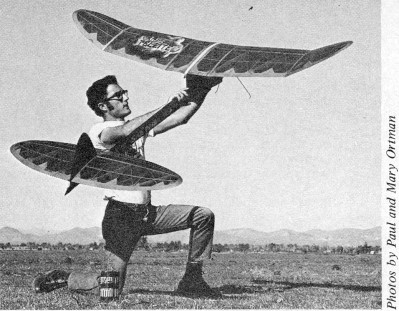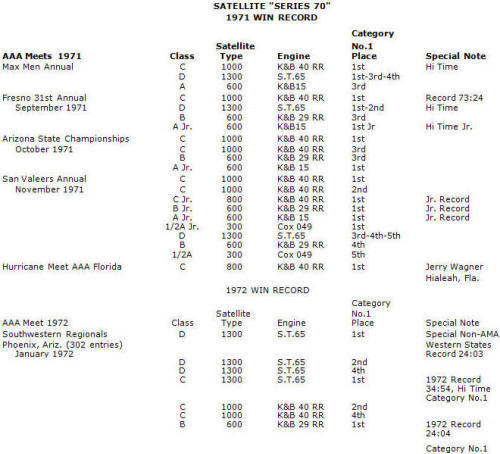|
At the request of website visitor Mark, these plans
and article for the Satellite 1000 Class C free flight airplane, by Bill Hunter, were scanned from my
purchased copy of the May 1972 American Aircraft Modeler magazine (page 22). Plans for this fine model
were drawn by Bill Hunter. All copyrights (if any) are hereby acknowledged.
Breaking News: See the guy in the background of the Cover Photo to the right? That's
Ed Aber-Song. See the photo he
was taking at the same time!
See the e-mail that
Mike Schwartz sent regarding
the Satellite series. Also, see the
1/2A Satellite article from
November 1957.
Satellite 1000
TAKE RAW POWER OF A RACING 40 FOR A ROCKETING CLIMB, FOLLOWED BY A SLOW LINGERING GLIDE BY ONE THOUSAND
SQUARE INCHES OF WING AND YOU HAVE MODELING'S MOST BEAUTIFUL SIGHT. THE WINNINGEST AMA POWER SHIP TODAY.
by Bill Hunter
The original Satellite 1000 was built in early 1959 to compete in the ultra-high power loading weight
rule of that year. The wing was built around the outline of the existing Satellite Series "57" plans.
This 1000 Class B job, bigger than I was at the time, was powered by a super hot Johnson 29R swinging
a 10x4 Grish nylon prop. The ultra-high loading rules made a "B" ship weigh 52.9 oz.-what a terrible
chore building a model that heavy. The fuselage was a fiberglass fishing rod and the pylon was solid
1/2" plywood, which alone weighed 16 oz.

Even so, it collected a lot of hardware that year, including first place Junior B Gas at the 1959
Nats-a major point contribution towards the Junior National Championship. It continued to win consistently
the next year, but the wing and stab were lost, along with every other wing and stab my father and I
owned, on the highway outside of Sly the, California on our way to the 1960 Nats at NAS Dallas-the top
of the car carrier blew off at 70 mph! I don't think I'll ever forget the sight and sound of cars and
trucks rolling over the product of our years of preparation. Lucky my fuselage was so heavy or it would
have been sucked out with everything else.
Free-flight modeling has seen a multitude of rule changes since that time. Weight impositions have
long since been removed, engines have become much more powerful, and a new Satellite 1000 is making
the contest scene, proving itself winner in all contests entered.
The Series 70 Satellite 1000 "C" Special was designed especially for the brute power delivered by
the K&S 40RR. If a thousand square inches of wing area seems a little large, take all factors into
consideration" The Satellite features an elliptical wing and stab that offer more than just pleasing
lines. Consider for a moment what happens to the 9% flat bottom section as it moves from the center
to the tips of the wing. Right, it becomes much thinner. Since the wing is elliptical, the 14-11/16"
chord at the center section becomes 12-1/8" at the tip dihedral break, and, in proportion, the 9% section
at the tip dihedral break is considerably thinner. As a result, drag is enormously reduced, allowing
the ship to move under power like a 700 sq. in. job of the typical square design. When the Satellite
flips out on top however, you get everyone of those thousand squares back, giving this ship a glide
second to none-as witnessed by many at the San Valeers Annual, November 14, 1971 at Taft, California.
Seven ships maxed out on Saturday including both the Satellite "C" Specials entered. Due to a sudden
dust and rainstorm, special flyoffs were held the next morning. Sunday morning dawned clear, cold and
calm with little or no lift. Everyone had to fly at approximately the same time, within two minute starting
time limit.

Tuning for launch. Wire skid landing gear is to cushion DT landings.
This was the perfect situation for power and glide comparisons, as the air was the same for all contenders.
The first flyoff was to be a seven-m in. max, increasing by two minutes each succeeding flight. Four
of the seven con-tenders were down within six and half minutes. Only one other ship besides the two
Satellites maxed. That ship glided down at 7:20-my father's Satellite and mine were up for 8:50 and
9: 14. The next flight saw the two Satellites flip out on top and stay that way. The two Satellite "C"
Specials finished in first and second place. Their wings and stabs were covered with one mil Mylar;
the fuselages were finished with K&B Superpoxy. The light weight of the Mylar helped hold the all-up
weigh of both ships to just under 35 oz., and gave them a 3.5 oz./100 wing loading.
The two "C" Specials first saw competition at the Fresno 31st Annual-September 24 and 25, 1971. This
meet allowed the contestants to fly any event scheduled either day. My Dad flew Class C, winning the
event and setting a new 1971 Open AMA record of 73:24. I elected to fly my "C" Special. I first entered
my plane in a Testors beauty award. The "C" Special won the beauty award, and I began flying official
trying to catch my Dad. But it was no use - the ship went out of sight overhead on the second max and
was lost. Luckily it was found by a friendly farmer and returned a week later. Then we headed for the
Arizona State Championships in Phoenix, where the Satellites took first and third in C Gas. All sizes
of the Satellite Series 70 have built up an outstanding win record.
Construction
With ease of construction a prime concern during the design stage of all Series 70 Satellites, detailed
assembly descriptions, full-size template drawings, and a bill of materials are part of each plan, so
in this case lengthy construction notes found in most articles are not necessary. We use Titebond
glue for all joints, and epoxy for laminations. The Series 70 Satellites are adaptable to several .
types of trim methods. Our favorite, as shown on the plans, is the right climb, left glide, achieved
by right thrust, left rudder, and left wing washout, all in moderation to achieve a 3/4 right power
turn in 15 seconds with a glide turn of 40 to 52 seconds.
VTO is a snap. When you've maxed out, VTO does not apply, so hand launch with your strongest throw
to take advantage of the short engine run. The wing is stressed to take it!

Satellite 1000 Plans<click for larger version>
Notice:
The AMA Plans Service offers a
full-size version of many of the plans show here at a very reasonable cost. They
will scale the plans any size for you. It is always best to buy printed plans because
my scanner versions often have distortions that can cause parts to fit poorly. Purchasing
plans also help to support the operation of the
Academy of Model Aeronautics - the #1
advocate for model aviation throughout the world. If the AMA no longer has this
plan on file, I will be glad to send you my higher resolution version.
Try my Scale Calculator for
Model Airplane Plans.

Posted July 23, 2010
|




